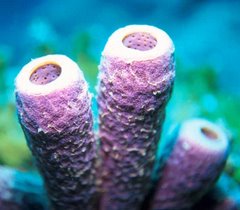
Sea sponges are filter feeders and mainly diet on tiny, floating organic particles known as plankton. When in the need of food, sponges depend on a system of pores, called ostia, and canals through which water passes. To better understand why the canals are important and how they aid in sponge feeding, it is key to first know the makeup of the canals, how they work and their main functions.
Within the canals of sea sponges, tubelike chambers are lined with specialized cells called choanocytes, or collar cells. Each collar cell has a sticky, funnel shaped collar and a hairlike whip called a flagellum. The collar cell serves two important purposes. First, the sticky collar works as a filter to strain out the smallest food items found in the water, such as plankton and individual bacteria. After a collar cell collects enough nutrients, another type of cell called an amoebocyte will transfer the food to other cells within the sponge. Second, the back and forth beating of the flagella drives water into the canals. The water makes collecting nutriends and oxygen possible, and carbon dioxide and waste easy to remove. The forces water through the sponge work to keep the animal alive and healthy.
Within the canals of sea sponges, tubelike chambers are lined with specialized cells called choanocytes, or collar cells. Each collar cell has a sticky, funnel shaped collar and a hairlike whip called a flagellum. The collar cell serves two important purposes. First, the sticky collar works as a filter to strain out the smallest food items found in the water, such as plankton and individual bacteria. After a collar cell collects enough nutrients, another type of cell called an amoebocyte will transfer the food to other cells within the sponge. Second, the back and forth beating of the flagella drives water into the canals. The water makes collecting nutriends and oxygen possible, and carbon dioxide and waste easy to remove. The forces water through the sponge work to keep the animal alive and healthy.


No comments:
Post a Comment